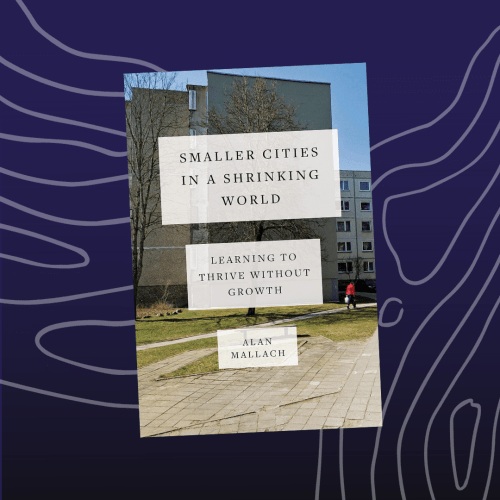 Read More
Read More
Finding strengths in shrinking cities

Conversations about cities and population most often center around explosive growth in the world's urban centers and concerns that stem from it: resource scarcity, space constraints, and more. And while this expansion and its impacts will be a challenge for years to come, there's another related global trend on the horizon: population decline.
In fact, even now, alongside a trend of rapid urbanization in sub-Saharan Africa over the next 30 years, a simultaneous trend of population loss is occurring in many cities in the United States, East Asia, Eastern Europe, and elsewhere. That's because growth in much of the world is slowing and could reverse in many countries by 2050, if not sooner.
That's why urban policy expert Alan Mallach tells Bloomberg Cities that now is the time for leaders in these mostly smaller peripheral cities to prepare for what a declining population will mean for them. In a new book, Smaller Cities in a Shrinking World, Mallach says that future does not have to be defined by the ills of vacant buildings, declining commerce, and reduced municipal revenues; it also can be an opportunity for cities to green the urban environment, address housing shortages, and become more self-sufficient in the goods and services they produce and consume.
Here are five ways city leaders can begin planning for a world in which shrinking cities, as Mallach predicts, will no longer be outliers but "increasingly the norm."
Determine if and how shrinking might impact your city.
When considering the implications of population decline, it's important for city leaders to start with understanding their local conditions to make realistic and informed projections of how this loss will impact their community. That's because there may be some generally expected impacts—from housing demand to economic inequity to municipal revenues—and the ways those challenges manifest themselves will be varied.
For example, one challenge Japan faces results from a declining birth rate, which is altering the "dependency ratio," or the number of working-age adults available to support people who are too young or old to work. This kind of change which can impact everything from tax revenues to child and elder care—on a city level might have different impacts and solutions than a decline in population caused by an employer leaving town.
Actual population loss may be the number that catches people's attention, but other metrics— like the number of households, age profile, and which neighborhoods are gaining or losing population—are more important to policy makers.
"When you start shrinking, it's not just about a number—there are a whole series of changes happening, whether it's the economic activity, the social character, the demographics, the age distribution, fiscal capacity, and so forth," Mallach says. "You have to understand what is happening in your city. You have to look at the trends and be able to extrapolate from them. You have to tie the economic, the real estate, the social, and the demographic together. Without a really good handle on data, city governments are going to flounder. It's as simple as that."
Consider a strategy of "networked localism" to address the impacts of population decline.
While state and national governments are able to provide some support to shrinking cities, Mallach says city leaders shouldn't expect that "the cavalry is going to ride in and save them." That means local leaders will need to look within their own assets, resources, and economic networks to thrive.
That's where something Mallach calls "networked localism" comes in. The idea is for cities to take advantage of new models of distributed energy production, decentralized manufacturing, remote work, telehealth, and more to produce more of the food, goods, services, and energy they use locally. This doesn't mean autarky, as Mallach notes, but rather creating strong, resilient, and dynamic local economies that can succeed during times of uncertainty and rebound from adversity.
Mallach hasn't seen a city that's put all of these pieces together yet, but he cites a few places that are doing some parts well. Burlington, Vt., for example, now gets all of its energy through renewable sources and generates about half of it locally through biomass and hydroelectric power. In Ithaca, N.Y., a food co-op that prioritizes locally produced food has gained significant local market share. And Tulsa, Okla., has drawn more than 1,200 remote workers since 2018, with a strategy that includes not only a $10,000 financial incentive but also a robust support system to connect remote workers and their families to the community once they arrive.
"There's a whole series of things that you can start thinking about," Mallach says, "when you look at how we can localize our economic and social and educational activities in ways that really work for the people here—and make it more attractive for people to stay in these communities."
Use innovation tools to find opportunities.
Shrinking cities can be fertile ground for urban innovations. Local governments can look to proven innovation tactics including leveraging data, resident engagement, and cross-sector collaboration to identify opportunities to take advantage of changes in the makeup of their city.
For instance, cities can repurpose vacant lots and land, simultaneously greening urban neighborhoods, restoring ecosystems, reducing heat, boosting local food production, and improving the quality of life for residents. A growing number of U.S. cities, such as Cleveland and Detroit, are using land banks to find new owners for tax foreclosed properties, even if that means selling them for $1.
Philadelphia is demonstrating another potential use, where the city has partnered with the Pennsylvania Horticultural Society to take care of more than a quarter of the city's 40,000 vacant lots. Instead of being places where weeds fester and trash piles up, these LandCare lots are tidy green spaces. And in Riga, Latvia, a group of residents turned a vacant space in the heart of the city where an ice hockey rink was demolished into a much-loved community garden.
Another benefit shrinking cities of the future can lean on is the ability to learn lessons from cities who have already experienced population loss, blight, lost industries, and outdated infrastructure, and have developed solutions. "The beauty of these kinds of innovations is you don't have to go into a lab and spend the next ten years reinventing the light bulb," Mallach says. "Whether it's in manufacturing, food systems, how to improve education and work, or create more age-friendly cities for seniors, the knowledge is out there. It's a matter of applying those ideas to your city."
Build a "community ecosystem" in cities.
Innovation thrives on the energy of residents, neighborhood organizations, and institutions when they feel welcome to contribute ideas and create change. Cultivating that sense of agency is especially important in a city that may be experiencing symptoms of population decline. "People have to feel empowered," Mallach says. "They have to feel that they have a stake in this city."
One way he proposes cities do this is by deploying a model from the world of educational reform that is not yet widely used in governments: distributed leadership. In schools, this involves empowering teachers to lead teams that contribute to priorities for the entire school. Local governments could deploy such an approach by setting up teams focused on particular areas—health, education, energy, etc.—and then play a coordinating role managing them. Most importantly, Mallach notes, the key isn't the specific system, but the underlying principle of engaging the creative energy of residents in the future of the city.
In addition to fostering new ways of engaging and sharing power with residents, Mallach says, it's also important to create shared physical spaces where all residents come together and experience their city together. One approach to this that's become more familiar over the past few years is closing streets to vehicular traffic. For instance, he points to how Vancouver closed a downtown street to pedestrian traffic for its "Porch Parade," an installation of brightly colored porches and front doors that brought thousands of people to the area. These efforts, he says, are most successful when they are an expression of a community's culture.
"The public realm is incredibly important," he says. "We need public spaces that people enjoy being in. We need the kinds of activities that bring people together. There are cities doing this, but not at the level it needs to happen. It has to be seen as a conscious, deliberate strategy to get people together, to make sure that all of these spaces are welcoming for all the different groups in the city."
Lead a positive path forward.
Population growth is linked with success—and population loss with failure—in many local leaders' minds. But as shrinking cities become more common, Mallach says, mayors will need to erase that stigma, and articulate an "aspirational but realistic vision" for what their cities can become as smaller versions of their former selves. "That doesn't mean that cities and nations need to loudly broadcast what is still widely seen as a sign of failure," he says, "but they have to be willing to take actions, sometimes difficult ones, that have the reality of shrinkage as their starting point."
As mayors set out down that path, they will need to practice adaptive leadership, mobilizing their communities to take on tough challenges together. And they'll need to forge partnerships—not only with community groups, but also with state and national governments, philanthropy, and others, to navigate what it means to be a smaller city in a shrinking world.
With shrinking cities set to become even more common in the future, local governments have an opportunity to understand how demographic changes might impact them and begin planning for the challenges that future will bring with it.


